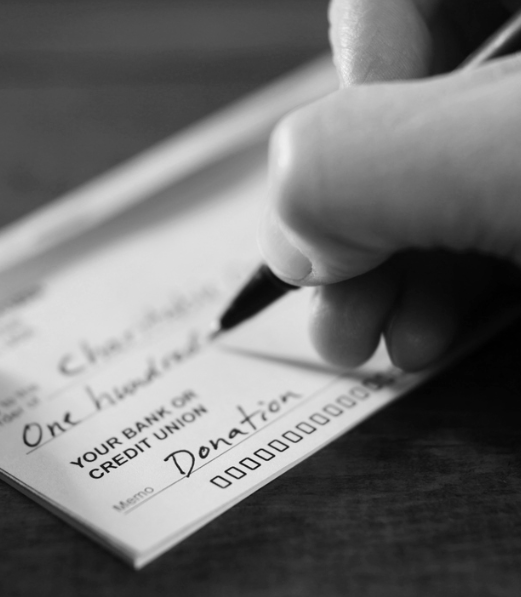BUILDING A LOYALTY PROGRAM FOR CHARITIES
Getting Started
While the hub of many commercial loyalty programs is their on-premise point of sale (which may also apply to nonprofit retailers), yours will more likely operate similarly to an e-commerce business, with your website being the root of your donor engagement.
The basis of any loyalty program is simple. The more frequently you buy (or donate, in this case), the more you’re rewarded. This incentive can come in an endless supply of colors, shapes, and sizes, and is typically awarded, cumulatively, through the collection of tokens like points, stars, or badges. When enough tokens are earned, they can be traded in for something of value, including a discount on future purchases, special benefits, upgrades, or gifts.
As you onboard new members (through your website, text to join, or social media), they’ll be added to your customer database, allowing you to automatically track each member’s donation history and engagement. Leverage this information to better segment, market to, and draw conclusions about your audience. Build automated awards systems that automatically and instantly reward each donor to your program, without having to lift a finger.
For nonprofits, we simply replace purchase amounts with various donation amounts. Nevertheless, the basic formula is still the same. When the value is applied strategically to engagement with your cause or brand, it can be used to help drive the volume, scale, and repetition of donations to your charity.

Creating Value
A frequent question for charities deploying a new loyalty marketing strategy is, “What do I have to give? Sure, we may award “loyalty points” or “dollars”, but what does this all add up to for the donor? I don’t have a back room full of products to discount or give away. So, where do I start?”
As a nonprofit, this can be a tricky, yet entirely possible, problem to solve for. Your value proposition is a balance of what you provide and how you make people feel, or what is often referred to in nonprofit loyalty as “the warm glow”. If you work to leverage both aspects of human nature, the value becomes immediately apparent.
Whatever the case, we want to take full stock of all the ways that organizations can create value among their members, understand all of the resources at play, and get creative with how we can build real value into our program.
Leveraging Soft Assets
Almost every organization has a small number of soft assets. These are awards that don’t carry a strict monetary value to them, such as the cost of goods.
Event Access – Early access to or priority seating at your next event.
Experiences – A personal tour of your facility.
Association – Public mentions of the member’s contributions to your program
Utilizing Partner Resources
As a not for profit, you commonly work with corporate partners. In as much as they view these donations as a purely philanthropic endeavor, they’re also looking to get something out of it. Whether that benefit boils to greater exposure for their brand among your donor list or tangible sales, your ability to create engagement around your brand is going to be a bellwether for their interest in forming an ongoing relationship with your non-profit.
Some partners are willing to donate cash to your nonprofit. Many are more willing to donate soft value assets like gift cards, prizes, and the like. Be careful not to undervalue these soft donations. They can be parlayed to garner smaller donations during pledge drives, fundraisers, et al. They also tend to drive additional spending with your retail partner, making your charity a smart investment for outside business.
Using the “Warm Glow”
As a charity, your internal resources are limited. You likely have some branded merchandise laying around but understand that the value of a shirt with your logo on it isn’t that you have especially nice shirts. It’s the pride of being seen in that shirt. Most people want to be known for doing something good.
In the same way, we can leverage emotional rewards towards building value around our most regular donors. An award, as such, and in the case of a non-profit, isn’t limited to goods exchanged. Often, it can be simply the feeling, recognition, or bragging rights that you’ve done a good thing.
- Inclusion
- Recognition
- Achievement

Driving Donations
The architecture for most loyalty programs involves an exchange of value. Now that we’ve identified what we have to offer, it’s time to decide what actions we want our members to take. And while cash donations always help, you likely have a broader set of common needs, all of which you can leverage a loyalty program to help meet:
For example, start by offering rewards for donating to your cause. Broaden your objectives by offering rewards for volunteering at your events or spreading the word about your charity’s needs on social media.
The capabilities around accomplishing these added functions may vary between platforms and networks, but don’t be afraid to push the boundaries of your loyalty investment. Creating goals such as sharing of your donor loyalty program can have a dramatic impact on awareness and boost the collateral value of your program.
Next, you want to create the rewards structure for your loyalty initiative. The meat of your program centers around the tokenization of your desired actions. For example, customers may be able to:
Earn 1 point for every $10 donated.
Earn 5 points for every hour volunteered.
Earn 10 points for every mention of your program on social media.
Add your charity’s own unique flare to your donor loyalty program by customizing your tokens. Make points into paws, musical instruments, medals, or virtually anything else.
Applying Benefits
When a participant has collected the requisite number of points or dollars, your loyalty program should automatically inform the donor that they’ve completed a goal and are now eligible for benefits. In a retail environment, these benefits are generally applied at the time of checkout or as part of your eCommerce checkout process, in real-time.
This will work effectively for items like merchandise, but you may need some extended help from your partners to award third- party gift cards or other benefits.

Amplifying Your Donations
Tiered Programs
One of the most successful retention strategies that direct-to-consumer loyalty programs have deployed involves tiered memberships. Dynamically generated tiers allow you to drive more regular donations based on your customer’s membership at a certain level of giving.
This shouldn’t be a new concept to any well-formed non-profit.
*Tiered programs can be combined with partner resources to offer each tier increasing discount levels with local partner businesses
Tiered Programs
Your charity likely has several critical times of year in which it needs to drive donations. Loyalty software can be used to award people for doing so.
- Point multipliers for donating during these high-impact times.
- Offer high-value rewards and donation matching
Matching Programs & Re-Donations
While someone could donate $500 to your charity, do you think they’d be willing to donate $750 if they knew that it was going to be matched by an outside resource? This is a popular and proven fundraising technique often used by media-based nonprofits with corporate sponsors.
Your loyalty program can be used to segment customers who gave to your charity during a specific matching donation campaign and send them a thank-you discount or gift card from your partner.




